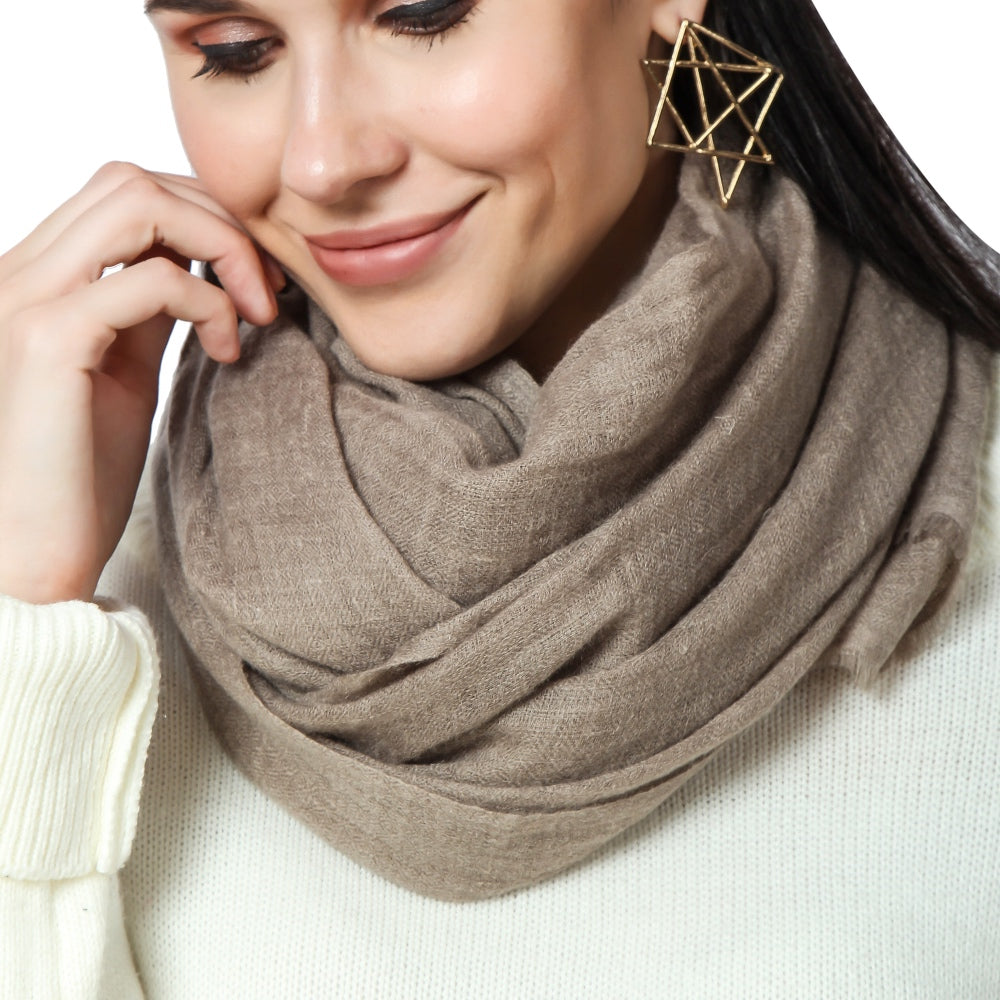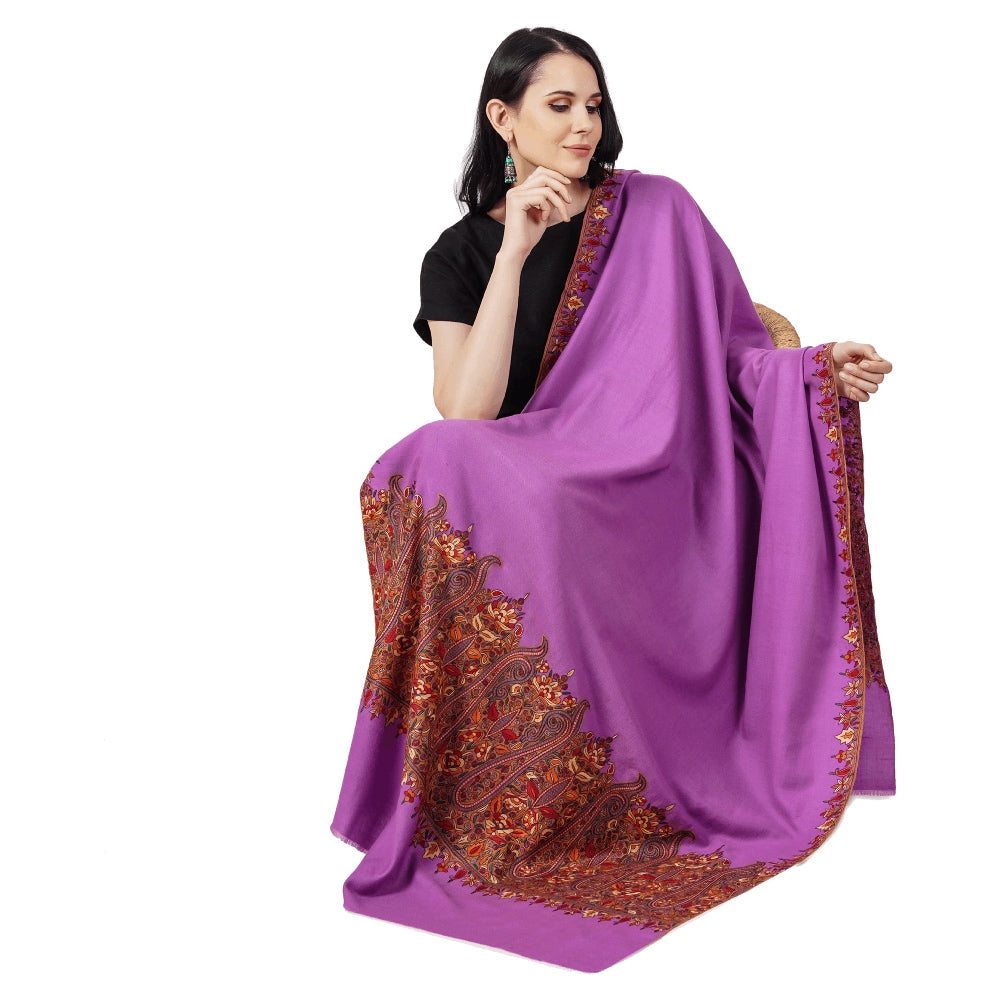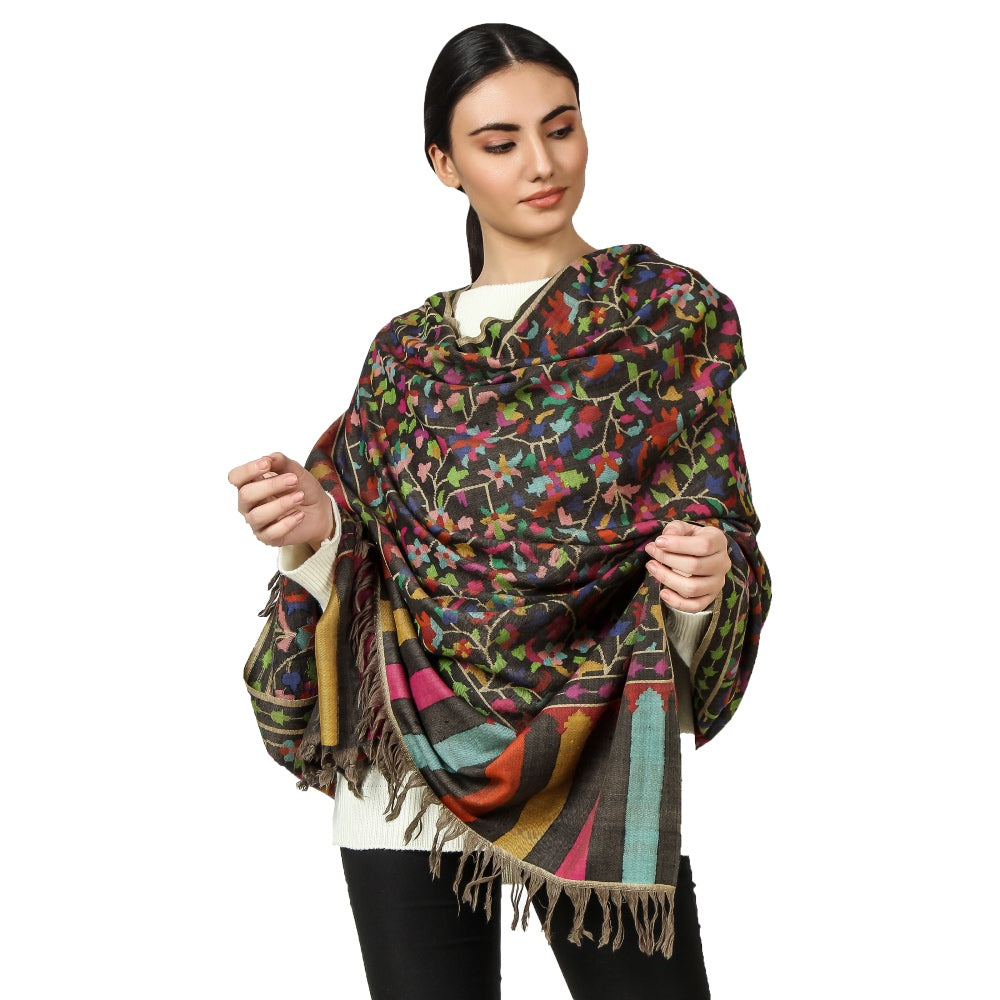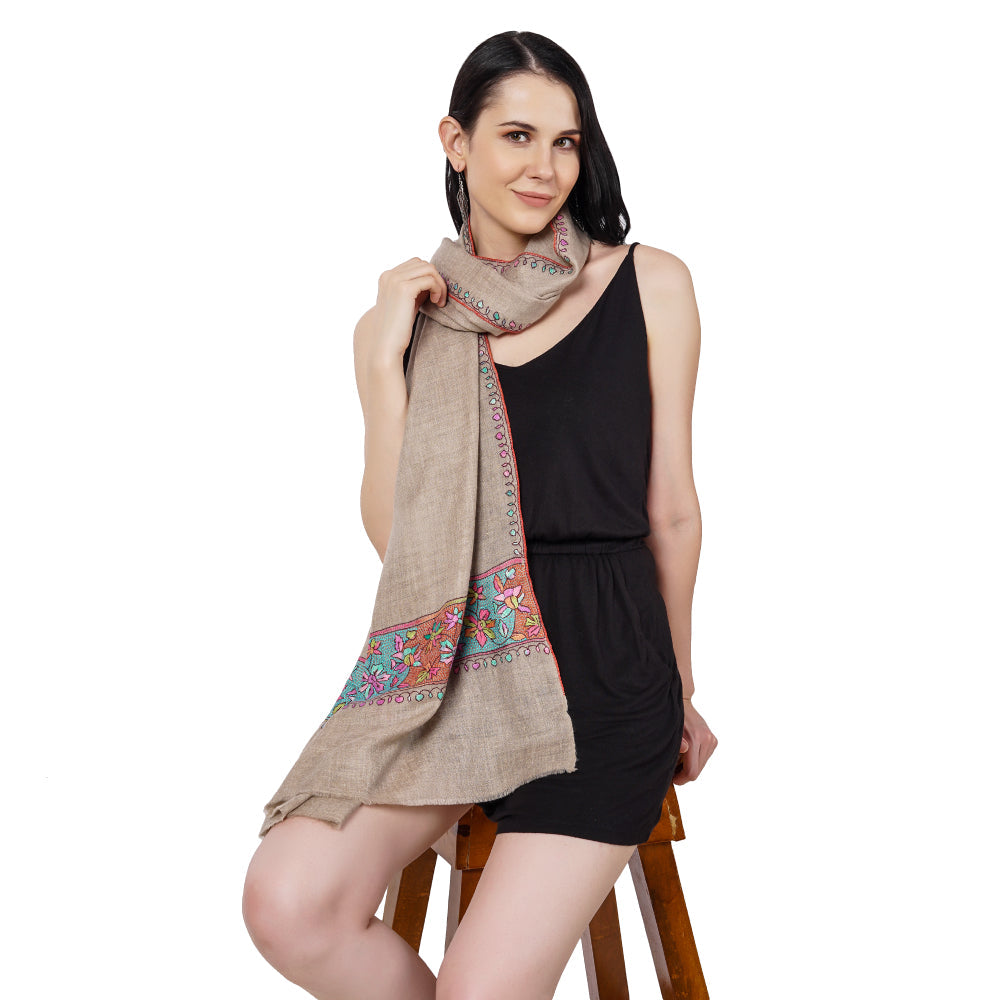
The Ultimate Guide: Exploring the Luxurious World of Pashmina and Cashmere
Share
Pashmina and Cashmere are two terms often used interchangeably to describe luxurious and highly sought-after fibers used in the production of high-quality textiles. Pashmina refers to a type of fine wool derived from the underbelly of a specific breed of Himalayan mountain goats, known as the Changthangi or Pashmina goat. These goats inhabit the rugged regions of Kashmir. Cashmere, on the other hand, broadly refers to the soft and warm fibers obtained from various breeds of goats, including the Pashmina goats, as well as other breeds found in different parts of the world, such as Mongolia and Inner Mongolia in China.
The history of Pashmina and Cashmere can be traced back thousands of years. The art of producing and weaving Pashmina and Cashmere textiles dates back to ancient civilizations in the Himalayan region, particularly in Kashmir. Pashmina shawls and Cashmere fabrics gained significant popularity and patronage during the Mughal Empire in the 15th and 16th centuries. Emperors and nobles were captivated by the softness, warmth, and intricate designs of these luxurious textiles. Pashmina and Cashmere products soon became synonymous with royalty and high social status.
In modern times, the popularity and demand for Pashmina and Cashmere have only grown stronger. The exquisite softness, lightweight feel, and exceptional warmth make these fibers highly coveted by fashion enthusiasts, artisans, and discerning consumers worldwide. Pashmina and Cashmere garments, scarves, and accessories are treasured for their elegance, versatility, and ability to elevate any outfit. The enduring appeal and timeless charm of Pashmina and Cashmere have made them symbols of luxury, sophistication, and indulgence in the fashion industry. Their demand continues to thrive as more people seek quality, sustainable, and ethically sourced materials for their wardrobe choices.

Understanding Pashmina
A. Origin and production of Pashmina
-
Introduction to the Pashmina goat Pashmina fibers are sourced from the underbelly of the Pashmina goat, also known as the Changthangi goat. These goats have adapted to the harsh climate and rugged terrain of the Himalayan region, where temperatures can plummet well below freezing. The Pashmina goat's thick, coarse outer coat provides protection from the cold, while the ultra-soft and fine undercoat, known as Pashm, is meticulously combed and collected for the production of Pashmina wool.
-
Traditional Pashmina manufacturing regions The traditional regions renowned for Pashmina production are primarily located in the Himalayan belt, encompassing areas of Kashmir, Nepal, and Tibet. Kashmir, particularly Srinagar, has been a historical hub for the handcrafted production of Pashmina shawls and textiles. The skill and artistry of the local artisans in these regions have played a crucial role in preserving the authenticity and craftsmanship associated with Pashmina.
Also read: What is pure Pashmina?
B. Characteristics and qualities of Pashmina
-
Softness and fineness of Pashmina fibers Pashmina is celebrated for its unparalleled softness and luxurious feel. The fibers are incredibly fine, often measuring less than 15 microns in diameter. This fineness contributes to the exceptional softness that is often compared to the touch of a feather or a cloud.
-
Warmth and insulation properties of Pashmina Despite its lightweight nature, Pashmina is highly prized for its excellent warmth and insulation properties. The fine fibers create air pockets within the fabric, which effectively trap body heat, providing optimal warmth and protection against cold weather conditions.
-
Lightweight and breathable nature of Pashmina One of the remarkable qualities of Pashmina is its lightweight nature. The fine fibers make the fabric feel airy and comfortable, allowing for ease of movement and draping. Additionally, Pashmina is highly breathable, preventing overheating and ensuring comfort in various climates.
C. Pashmina versus Cashmere: What sets them apart?
-
Differentiating factors between Pashmina and Cashmere While Pashmina is a type of Cashmere, there are distinguishing factors between the two. Pashmina specifically refers to the wool derived from the Pashmina goat found in the Himalayan region, whereas Cashmere is a broader term encompassing fibers from various goat breeds worldwide. Pashmina is known for its exceptionally fine and soft fibers, while Cashmere from other breeds may have slightly coarser textures.
-
Geographical and cultural associations of Pashmina Pashmina holds strong geographical and cultural associations with the Himalayan region, particularly Kashmir, Nepal, and Tibet. The indigenous communities in these areas have mastered the art of Pashmina production, passing down their skills and knowledge from generation to generation. The rich cultural heritage and traditional craftsmanship associated with Pashmina add to its allure and value in the global market.
Also read: Is Pashmina and Cashmere the Same?
The Marvel of Cashmere
A. The origins and history of Cashmere
-
Introduction to the Cashmere goat Cashmere fibers are obtained from various breeds of goats, including the Cashmere goat. The Cashmere goat, also known as the Kashmir goat, is believed to have originated in the region of Kashmir in present-day India and Pakistan. These goats have adapted to survive in harsh climates, where winters are extremely cold and summers scorching hot. They have a thick outer coat that protects them from the elements, while the soft and downy undercoat, known as Cashmere, is what makes them so highly prized.
-
Historical significance and trade routes of Cashmere Cashmere has a long and fascinating history. The production and trade of Cashmere can be traced back centuries, with records of its use in ancient civilizations such as Persia and China. It was during the 14th century that Cashmere started gaining popularity in Europe. The trade routes known as the "Silk Road" played a crucial role in the dissemination of Cashmere to different parts of the world, facilitating its demand and creating a thriving industry.
B. Qualities and characteristics of Cashmere
-
Exceptional softness and luxury of Cashmere fibers Cashmere fibers are renowned for their exceptional softness and luxurious feel. They are significantly finer than traditional wool, measuring between 14 to 19 microns in diameter. This delicate fineness is what gives Cashmere its unparalleled softness, often described as silky and velvety to the touch.
-
Insulating properties and temperature regulation Cashmere is prized for its excellent insulating properties. The fine fibers create tiny air pockets within the fabric, which trap body heat and provide optimal warmth in cold weather. At the same time, Cashmere is also remarkably breathable, allowing for temperature regulation and preventing overheating.
-
Durability and longevity of Cashmere products Despite its delicate and soft nature, Cashmere is surprisingly durable and long-lasting when properly cared for. The unique structure of Cashmere fibers contributes to their resilience and ability to withstand wear and tear. With proper maintenance, Cashmere products can retain their luxurious qualities for many years, making them valuable investments.
C. Cashmere in the Fashion Industry
-
Prestige and desirability of Cashmere garments Cashmere has long been associated with prestige and luxury in the fashion industry. Its rarity, exquisite softness, and high production standards make Cashmere garments highly coveted by fashion connoisseurs. Wearing a Cashmere piece is not only a statement of style but also a symbol of sophistication and refined taste.
-
Popular uses of Cashmere in fashion and accessories Cashmere is widely used in various fashion applications, ranging from sweaters, cardigans, and coats to scarves, hats, and gloves. Its versatility allows it to be seamlessly integrated into different styles and occasions. Cashmere accessories, in particular, have gained popularity for their elegance and ability to elevate any outfit, adding a touch of luxury and comfort.
Pashmina and Cashmere Production Process
A. Harvesting the fibers
-
Collecting the downy undercoat The first step in the production process of Pashmina and Cashmere involves harvesting the valuable downy undercoat from the goats. This is typically done during the spring season when the goats naturally shed their winter coat. Skilled herders carefully comb or manually hand-pluck the undercoat from the goats, ensuring that only the softest and finest fibers are collected.
-
Ethical considerations in Pashmina and Cashmere production Ethical considerations are of utmost importance in Pashmina and Cashmere production. Responsible herders prioritize the well-being and welfare of the goats, ensuring they are not subjected to any harm or stress during the harvesting process. Ethical practices include proper animal care, sustainable grazing practices, and maintaining the overall health and quality of the goat herds.
B. Processing and sorting
-
Cleaning and de-hairing the fibers After the fibers have been harvested, they undergo a cleaning process to remove impurities such as dirt, dust, and natural oils. This is typically done by gently washing the fibers using mild detergents or natural cleaning agents. Once clean, the fibers are carefully de-haired to separate the coarse outer guard hairs from the soft undercoat. De-hairing is often done through a meticulous combing or carding process.
-
Sorting and grading based on quality Once de-haired, the fibers are sorted and graded based on their quality. Skilled workers assess various factors, including fineness, length, color, and overall texture. The finest and softest fibers are classified as the highest grade and command a premium price in the market. The sorting and grading process ensure that only the best quality fibers are used in the production of Pashmina and Cashmere products.
C. Spinning and weaving techniques
-
Traditional methods of spinning Pashmina and Cashmere Traditionally, Pashmina and Cashmere fibers were spun into yarn using age-old spinning techniques. Artisans would skillfully hand-spin the fibers using a spinning wheel or spindle, carefully creating a fine, consistent yarn. This traditional spinning process allows for precise control over the yarn's thickness and the preservation of the fibers' natural softness.
-
Modern manufacturing techniques and technology In recent times, modern manufacturing techniques and technology have also been adopted in the production of Pashmina and Cashmere products. Mechanical spinning machines are used to efficiently spin the fibers into yarn, ensuring consistency and high production volumes. Advanced weaving technologies, including jacquard looms and power looms, are employed to weave the yarn into various textile patterns, designs, and finished products.
Both traditional and modern production methods are valued in the industry, with artisans and manufacturers often combining the two to meet the demands of the market while preserving the unique qualities and craftsmanship associated with Pashmina and Cashmere.
Care and Maintenance of Pashmina and Cashmere
A. Cleaning and washing guidelines
-
Handwashing techniques for Pashmina and Cashmere Handwashing is often the preferred method for cleaning Pashmina and Cashmere garments to maintain their delicate fibers. Fill a basin or sink with lukewarm water and add a mild detergent specifically formulated for delicate fabrics. Gently agitate the garment in the soapy water, taking care not to rub or wring it. Rinse thoroughly with clean water and gently squeeze out the excess water. Lay the garment flat on a clean towel and reshape it to its original dimensions. Allow it to air dry away from direct sunlight or heat sources.
-
Professional dry-cleaning options If you prefer not to wash your Pashmina or Cashmere items at home, professional dry-cleaning is an alternative. Look for a reputable dry cleaner with experience handling delicate fabrics. Inform them about the specific requirements of Pashmina or Cashmere and any stains or issues that need attention. Professional dry-cleaning can help remove stubborn stains and ensure proper care for your garments.
B. Storing Pashmina and Cashmere
-
Tips for storing Pashmina and Cashmere garments: Proper storage is essential to maintain the quality and longevity of your Pashmina and Cashmere garments. Clean your items before storage to prevent any lingering stains or odors. Fold the garments neatly and avoid hanging them, as this can cause stretching or distortion. Choose a cool, dry, and well-ventilated storage area, such as a drawer or shelf, to protect them from moisture and humidity. Avoid storing them in plastic bags, as they can trap moisture and lead to mold or mildew growth.
-
Protecting against pests and damage: Pashmina and Cashmere fibers are susceptible to damage from moths and other pests. To protect your garments, place cedar balls, lavender sachets, or moth repellents in your storage area. These natural deterrents help keep pests at bay. Additionally, avoid storing Pashmina and Cashmere near sharp objects or jewelry that can snag or pull the fibers. Folding them with acid-free tissue paper can provide extra protection and help maintain their shape.
By following these care and maintenance guidelines, you can ensure that your Pashmina and Cashmere garments remain in excellent condition, preserving their softness, warmth, and luxurious qualities for years to come.
How to Spot Authentic Pashmina and Cashmere
A. Understanding labeling and certifications
-
Recognized certifications for Pashmina and Cashmere When looking for authentic Pashmina and Cashmere products, it is helpful to be familiar with recognized certifications that guarantee their quality and origin. Some well-known certifications include the "Pashmina" label issued by the Government of India and the "Cashmere" label provided by the Cashmere and Camel Hair Manufacturers Institute (CCMI) in the United States. These certifications ensure that the products meet specific standards and have been produced using genuine Pashmina or Cashmere fibers.
-
Evaluating authenticity through labeling Carefully examine the labeling of Pashmina and Cashmere products. Look for clear and accurate information regarding the fiber content. Authentic products should clearly state the percentage of Pashmina or Cashmere in the composition. Additionally, labels may provide details about the country of origin, fiber grading, or any other relevant information that assures the authenticity and quality of the product.
B. Assessing the quality and feel
-
Examining the softness and fineness of fibers Authentic Pashmina and Cashmere are known for their exceptional softness and fineness. When assessing the quality of a product, gently touch and feel the fabric. It should have a luxuriously soft and smooth texture, often described as "buttery" or "silky." Authentic fibers are remarkably fine, typically measuring below 19 microns for Cashmere and below 15 microns for Pashmina. The delicate nature of the fibers contributes to their incredible softness and comfort.
-
Checking for warmth and insulation properties Another characteristic of authentic Pashmina and Cashmere is their excellent warmth and insulation properties. These fibers provide exceptional heat retention while remaining lightweight and breathable. To assess this, hold the fabric against your skin or drape it over your shoulders. It should create a warm and cozy feeling without feeling bulky or heavy. The insulating properties of genuine Pashmina and Cashmere make them ideal for providing comfort and protection in colder climates.
By understanding the significance of labeling and certifications, as well as evaluating the quality and feel of the fabric, you can confidently identify authentic Pashmina and Cashmere products. The softness, fineness, warmth, and insulation properties are key indicators of their authenticity, ensuring that you are investing in genuine and luxurious Pashmina or Cashmere items.
Also read: Where can I buy Pashmina Shawls
Styling Tips: Incorporating Pashmina and Cashmere into Your Wardrobe
A. Pashmina and Cashmere scarves
-
Different ways to wear a Pashmina or Cashmere scarf Pashmina and Cashmere scarves offer versatile styling options. They can be worn in various ways, such as draping it loosely around the neck, wrapping it as a shawl, or even tying it as a belt. Experiment with different scarf knots, like the classic loop knot or the stylish waterfall knot, to add a touch of elegance to your outfit.
-
Pairing scarves with various outfits and occasions Pashmina and Cashmere scarves effortlessly elevate any outfit. For a casual look, pair a colorful scarf with jeans, a basic top, and boots. To add sophistication to a dress or a formal outfit, opt for a solid-colored or patterned scarf in complementary tones. Scarves can also be used as statement pieces, adding a pop of color or texture to a monochromatic ensemble.
B. Pashmina and Cashmere sweaters
-
Choosing the right style and fit for a Cashmere sweater When selecting a Cashmere sweater, consider the style and fit that best suits your body type and personal style. Classic crewneck or V-neck sweaters are versatile and timeless, suitable for various occasions. For a more relaxed look, opt for an oversized or chunky Cashmere sweater. Slim-fit or cropped styles can be paired with high-waisted bottoms for a modern and chic ensemble.
-
Layering and accessorizing Cashmere sweaters Cashmere sweaters are perfect for layering. Wear them over a collared shirt for a preppy and polished look, or layer them under a blazer for a sophisticated office outfit. Accessorize your Cashmere sweater with a statement necklace or a silk scarf tied around the neck to add a touch of glamour. Additionally, consider pairing your sweater with tailored trousers, skirts, or even leather leggings for a fashionable twist.
Also read: How do you wear a Pashmina to a wedding?
Frequently Asked Questions (FAQs)
A. What is the difference between Pashmina and Cashmere?
Pashmina and Cashmere are terms often used interchangeably, but they have slight differences. Pashmina refers specifically to the fine undercoat fibers obtained from the Cashmere goat, while Cashmere encompasses the general term for the soft fibers from various goat breeds. Pashmina is known for its exceptional softness and fineness, making it highly coveted in luxury textiles.
B. How are Pashmina and Cashmere made?
Pashmina and Cashmere are made by harvesting the downy undercoat of goats, particularly the Cashmere goat. The fibers are carefully collected, cleaned, and sorted to remove impurities and separate the soft undercoat from the coarse outer guard hairs. The fibers are then spun into yarn and woven into various textiles, including scarves, sweaters, and blankets.
C. Are Pashmina and Cashmere sustainable?
Pashmina and Cashmere production can be sustainable when ethical and responsible practices are followed. Sustainable Pashmina and Cashmere production involves proper animal welfare, including grazing practices that promote healthy ecosystems and prevent overgrazing. Additionally, sustainable practices prioritize fair trade, supporting the livelihoods of communities involved in the production process while ensuring the protection of natural resources. Choosing products from reputable sources that adhere to sustainable practices can help support the sustainable Pashmina and Cashmere industry.






